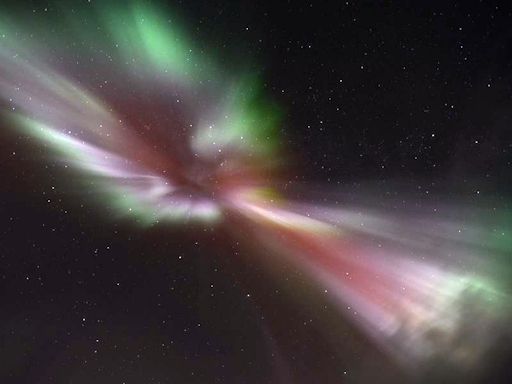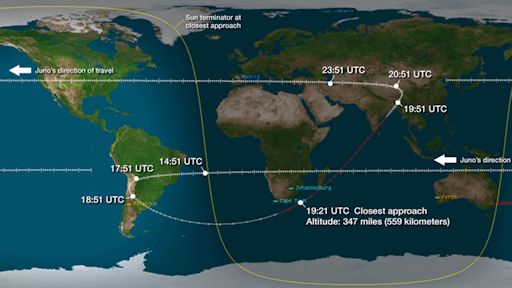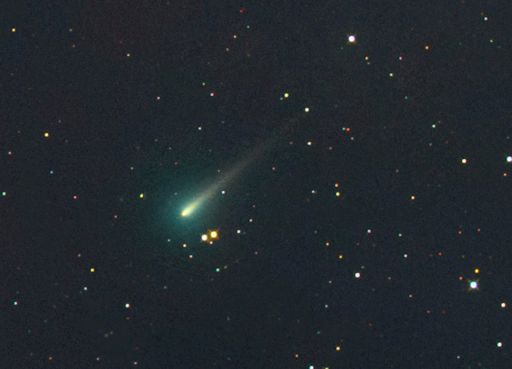M-CLASS SOLAR FLARE: Solar activity is picking up. New sunspot AR1865 erupted this morning (Oct. 9th at 01:48 UT), producing the strongest solar flare in nearly two months. NASA's Solar Dynamics Observatory recorded the M2.8-class eruption: movie. Earth was not in the line of fire, but future eruptions could be geoeffective as the sunspot turns toward our planet in the days ahead. Solar flare alerts: text, voice.
CME IMPACT, GEOMAGNETIC STORM: An interplanetary shock wave, possibly the leading edge of a CME, hit Earth's magnetic field on October 8th at approximately 2015 UT (1:15 pm PDT). The impact sparked a G1-class geomagnetic storm (in progress) and bright auroras around the Arctic Circle. Lana Rupp photographed this "stunning display of color" over Borgarnes, Iceland, during the early hours of Oct. 9th:
Earth is passing through the wake of the CME where a region of high-speed solar wind continues to buffet our planet's magnetic field. NOAA forecasters, who suspect that a second CME might arrive on Oct. 9th, estimate a 65% chance of polar geomagnetic storms during the next 24 hours. High-latitude sky watchers should remain alert for auroras. Aurora alerts: text, voice.
JUNO SPACECRAFT TO FLY BY EARTH: NASA's Juno spacecraft will slingshot past Earth today, October 9th, for a velocity boost en route to Jupiter. At closest approach (19:21 UT, 12:21 PDT) the spacecraft will be only 347 miles above Earth's surface. This map shows the spacecraft's ground track:
During the flyby, Juno's science instruments will be activated to sample the Earth environment--a practice run for data-taking when the spacecraft reaches Jupiter in 2016. Despite the shutdown of the US government, "the flyby will continue as planned," says Juno principal investigator Scott Bolton of the Southwest Research Institute. "The commands associated with our instruments were already on board before the shutdown."
To celebrate this event, the Juno team invites amateur radio operators around the world to say "HI" to Juno in a coordinated Morse Code message. Juno's radio and plasma wave experiment, called Waves, should be able to detect the message if enough people participate. Please join in, and help spread the word to fellow amateur radio enthusiasts.
The spacecraft will not be visible to the unaided eye. Estimates of its maximum brightness range from magnitude +7.5 to +8.5. Such a faint object moving rapidly across the sky will be a challenge for even large backyard telescopes. There is a slim chance, however, that sky watchers could see a "Juno flare" if sunlight glints off the spacecraft's large solar arrays. Anyone who successfully photographs the spacecraft is encouraged to submit their images.
PS: If you want to see a really bright spacecraft, download our Satellite Tracker app and check out the International Space Station.
Realtime Space Weather Photo Gallery
COMET ISON IN COLOR: Comet ISON is brightening as it approaches the sun. Estimates by experienced observers put the comet between 10th and 11th magnitude. That's too dim to see with the unaided eye, but bright enough for color photography through mid-sized backyard telescopes. Michael Jäger of Weißenkirchen, Austria, observed the comet on Oct. 5th and found that it was green:
To image the comet, Jäger combined multiple exposures through red, green, blue, ultraviolet and infrared filters. Details may be found here.
ISON's green color comes from the gases surrounding its icy nucleus. Jets spewing from the comet's core probably contain cyanogen (CN: a poisonous gas found in many comets) and diatomic carbon (C2). Both substances glow green when illuminated by sunlight in the near-vacuum of space.
Finding Comet ISON is easy. It rises alongside Mars in the eastern sky just before dawn. Amateur astronomers, if you have a GOTO telescope, enter these coordinates. Special dates of interest include Oct. 13-15 when Mars, Comet ISON, and the first magnitude star Regulus will be clustered in a patch of sky less than 3o apart. Red Mars and blue Regulus will form a beautiful naked eye "double star" in the early morning sky. Sky maps: Oct. 8, 9, 10, 11, 12, 13, 14, 15.

Solar wind
speed: 563.8 km/sec
density: 6.5 protons/cm3
explanation | more data
Updated: Today at 1417 UT
X-ray Solar Flares
6-hr max: B4 1143 UT Oct09
24-hr: M2 0148 UT Oct09
explanation | more data
Updated: Today at: 1400 UT
![]()
Daily Sun: 09 Oct 13
Emerging sunspot AR1865 poses a threat for M-class solar flares. Credit: SDO/HMI
![]()
Sunspot number: 99
What is the sunspot number?
Updated 09 Oct 2013
Spotless Days
Current Stretch: 0 days
2013 total: 0 days (0%)
2012 total: 0 days (0%)
2011 total: 2 days (<1%)
2010 total: 51 days (14%)
2009 total: 260 days (71%)
Since 2004: 821 days
Typical Solar Min: 486 days
Update 09 Oct 2013
The Radio Sun
10.7 cm flux: 112 sfu
explanation | more data
Updated 09 Oct 2013
![]()
Current Auroral Oval:
Switch to: Europe, USA, New Zealand, Antarctica
Credit: NOAA/POES
![]()
Planetary K-index
Now: Kp= 4 unsettled
24-hr max: Kp= 5 storm
explanation | more data
Interplanetary Mag. Field
Btotal: 9.1 nT
Bz: 1.6 nT north
explanation | more data
Updated: Today at 1417 UT
![]()
Coronal Holes: 09 Oct 13
Solar wind flowing from this coronal hole should reach Earth on Oct. 11-12. Credit: SDO/AIA.







